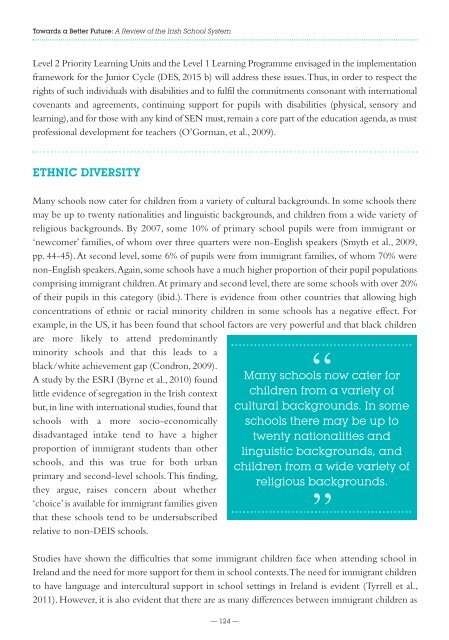Towards a Better Future
A Review of the Irish School System John Coolahan | Sheelagh Drudy Pádraig Hogan | Áine Hyland | Séamus McGuinness
A Review of the Irish School System
John Coolahan | Sheelagh Drudy Pádraig Hogan | Áine Hyland | Séamus McGuinness
You also want an ePaper? Increase the reach of your titles
YUMPU automatically turns print PDFs into web optimized ePapers that Google loves.
<strong>Towards</strong> a <strong>Better</strong> <strong>Future</strong>: A Review of the Irish School System<br />
Level 2 Priority Learning Units and the Level 1 Learning Programme envisaged in the implementation<br />
framework for the Junior Cycle (DES, 2015 b) will address these issues. Thus, in order to respect the<br />
rights of such individuals with disabilities and to fulfil the commitments consonant with international<br />
covenants and agreements, continuing support for pupils with disabilities (physical, sensory and<br />
learning), and for those with any kind of SEN must, remain a core part of the education agenda, as must<br />
professional development for teachers (O’Gorman, et al., 2009).<br />
ETHNIC DIVERSITY<br />
Many schools now cater for children from a variety of cultural backgrounds. In some schools there<br />
may be up to twenty nationalities and linguistic backgrounds, and children from a wide variety of<br />
religious backgrounds. By 2007, some 10% of primary school pupils were from immigrant or<br />
‘newcomer’ families, of whom over three quarters were non-English speakers (Smyth et al., 2009,<br />
pp. 44-45). At second level, some 6% of pupils were from immigrant families, of whom 70% were<br />
non-English speakers. Again, some schools have a much higher proportion of their pupil populations<br />
comprising immigrant children. At primary and second level, there are some schools with over 20%<br />
of their pupils in this category (ibid.). There is evidence from other countries that allowing high<br />
concentrations of ethnic or racial minority children in some schools has a negative effect. For<br />
example, in the US, it has been found that school factors are very powerful and that black children<br />
are more likely to attend predominantly<br />
minority schools and that this leads to a<br />
“<br />
black/white achievement gap (Condron, 2009).<br />
A study by the ESRI (Byrne et al., 2010) found<br />
little evidence of segregation in the Irish context<br />
but, in line with international studies, found that<br />
schools with a more socio-economically<br />
disadvantaged intake tend to have a higher<br />
proportion of immigrant students than other<br />
schools, and this was true for both urban<br />
primary and second-level schools. This finding,<br />
they argue, raises concern about whether<br />
‘choice’ is available for immigrant families given<br />
that these schools tend to be undersubscribed<br />
relative to non-DEIS schools.<br />
Many schools now cater for<br />
children from a variety of<br />
cultural backgrounds. In some<br />
schools there may be up to<br />
twenty nationalities and<br />
linguistic backgrounds, and<br />
children from a wide variety of<br />
religious backgrounds.<br />
”<br />
Studies have shown the difficulties that some immigrant children face when attending school in<br />
Ireland and the need for more support for them in school contexts. The need for immigrant children<br />
to have language and intercultural support in school settings in Ireland is evident (Tyrrell et al.,<br />
2011). However, it is also evident that there are as many differences between immigrant children as<br />
— 124 —



